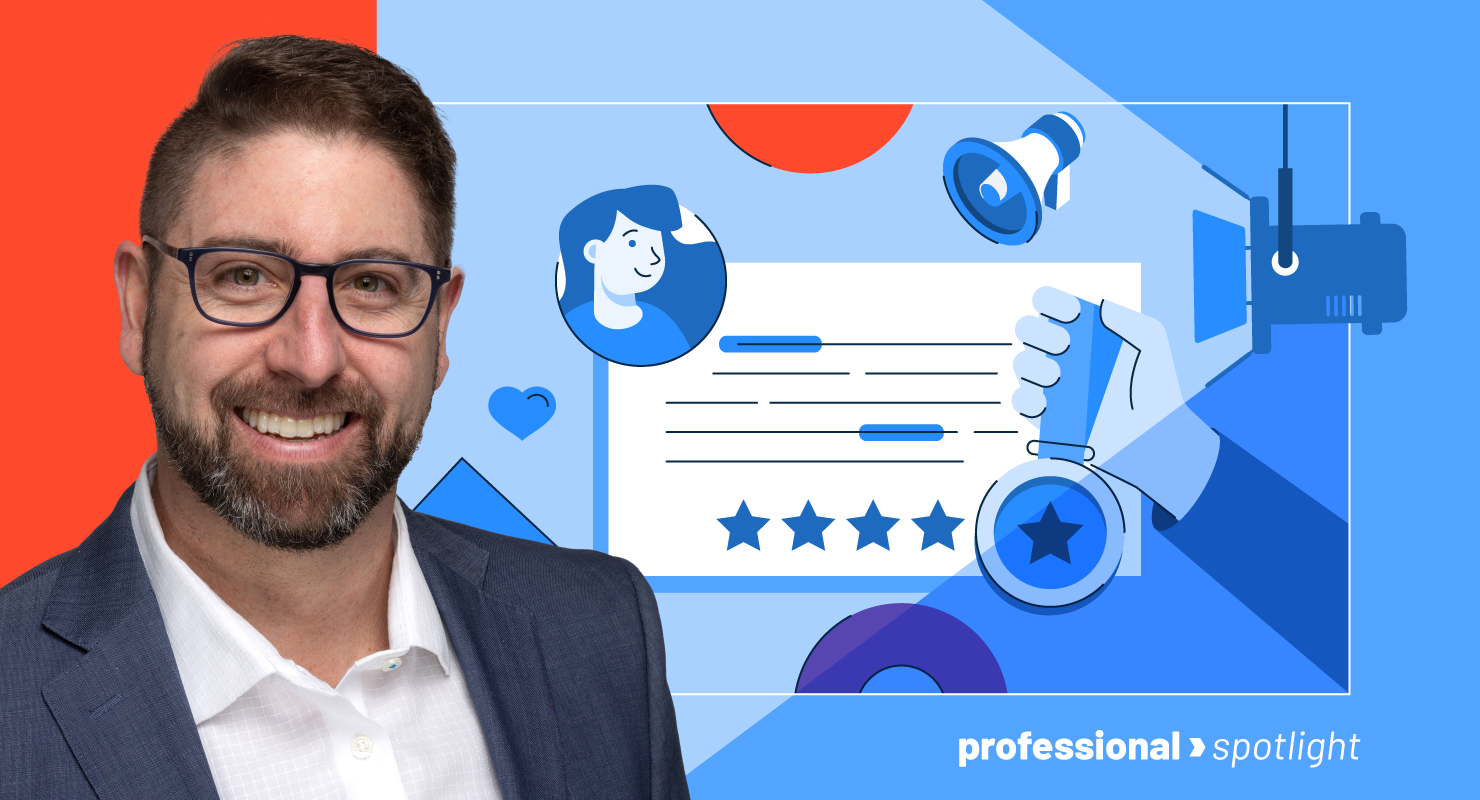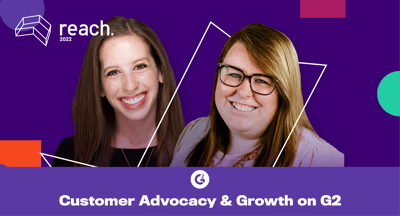July 5, 2023
 by Sudipto Paul / July 5, 2023
by Sudipto Paul / July 5, 2023

If you're in sales or customer success, you know how your company is pulling out all the stops to make that net new sale right now.
But, if your exclusive focus is on marketing returns, your company will observe an inverted hockey stick trend because of the noisy spray-and-pray method. Scaling marketing programs for the post-sale experience is essential to stand out. Get your customers to be your champions, and they'll spread the word for you.
I had the pleasure of chatting with Ari Hoffman, VP of Customer Marketing and Advocacy at Influitive, to learn how companies can unleash the power of customer advocacy. During our talk, Ari shared how he transitioned into customer marketing, how brands can start customer advocacy programs, and how to leverage customers' voices to win new customers.
This interview is part of G2's Professional Spotlight series. For more content like this, subscribe to G2 Tea, a newsletter with SaaS-y news and entertainment.
What's your favorite beverage? Tea. I love all teas — Tasani, Oolong, and Darjeeling tea. I'm a big tea fan. I like everything from the floral and the hibiscus to the rich and the dark.
When do you enjoy it? When I need a little pick-me-up and need a little flavor.
What was your first job? My first non-paying job was cleaning out the poop and pee from the dog pens in a pet shop. If I cleaned all the pens, they would let me play with all the puppies at the end of the day when the shop closed. I love dogs so much, so that was my favorite thing to do. I did it three times a week. My first paying job was at 14 or 15. I was a host at the Malibu Inn restaurant. I would let people in the door, find them seats, and book reservations.
What's your favorite software in your current tech stack? Influitive.
What problems at work make you want to throw your laptop out the window? I haven't had those in a while. But many times, the frustration is actually on me, where I'm unable to communicate properly. You know those moments where you have to teach up and down, and sometimes you feel like people just don't get it. You don't understand what you're doing wrong and why you're explaining in a way that doesn't make sense or resonate. Those can be very, very frustrating moments.
Sudipto Paul: You talked about how frustrating it is when people don't understand what you're saying. How can we avoid that while communicating with customers?
Ari Hoffman: Well, it's not just to customers. It's to employees, peers, colleagues, and everyone. It's taking a step back, taking a breath, and understanding and empathizing with everyone and how busy and full their plates are.
When you've got a cup so full, pouring anything else in it is hard. So, it's not always their fault, especially if they're not working on it daily and don't have the same perspective as you.
You have to be patient and tolerant, and devise clever ways to help them understand how it relates to what they're doing now. So, how do you empathize, right? How do you find ways to change their perspective toward yours? It's not by pushing ideas on them. It's by pulling them through their own interests toward what you're trying to get at.
So, if I'm talking to the sales leadership about how the reference program needs to adapt, I will talk about how this helps velocity, time to close a deal, and conversion rates. How does this help improve the adoption rate once a customer becomes a customer?
I will talk about those things that resonate with them to get them onto the points that matter. From there, they will start wanting to know, understand, and support you.
That makes so much sense. Now, let's go back to how you started your career in architecture and slowly moved to customer marketing over the years. What was that journey like, and what made you transition to customer advocacy?
Yes, it's funny you said I eventually moved into a customer marketing role. There was no field of customer marketing when I started in tech, and I haven't been in tech that long. Some people think I've been doing this for 20 years. I've been doing this for eight now.
I started in 2015 as an onboarding manager. I quickly evolved to be somewhat like an evangelist for the company. The CEO said he couldn't be everywhere at all times and wanted me to be out there since people resonated with me and customers liked me.
That was an awkward position for me. Because, one, I didn't feel like a subject matter expert in our field. I was talking to people much smarter than me. Two, I like showing other people off more.
So, I started just doing this with customers everywhere I went. I would co-host sessions with customers instead of just having my own sessions. I also noticed those resonate more with people.
I kept doing that, and at the same time, I was doing these top 100 lists and other campaigns like push and pull events in person. We would schedule these extensive sessions around big conferences. Every time we returned from them, I would have to go through the justification process of why it's important to do these things, even if the last time we did it, we were getting pats on the back and people saying, "this is the greatest campaign we've ever done."
It felt like you were in that washing machine cycle on repeat. And this wasn't efficient because I spent so much time justifying instead of just building and doing.
I know from the business side that there's a risk and reward aspect, and you've got to understand the business impact. But the question remained: why are we going through this? Plus, I noticed the economy was already switching from a business and sales standpoint. We were moving from perpetual sales to a subscription model. That's where customer success blossomed. It was about getting value on day one.
But I was looking at our marketing content, and how we approached marketing was still in that perpetual sales model. We were doing these one-off events, and nothing was tied together. There was always that question — what do we do next with this? We had a great Dreamforce showing. What do we do after Dreamforce? How do we follow up? How do we continue that momentum? And with each event, it was the same kind of conversation.
So I said there has to be a better way. What was simultaneously adding to the frustration, hard work, and repeated cycle was my CSMs coming to me saying — Hey, Ari, X customer went dark on me, or Z account isn't responding anymore. I know you have a good relationship with them. Can you reach out for me?
That hit me because I'm not special. I'm not different from anybody else, but I'm doing something different. So, I looked at why I could build these types of relationships where others couldn't. And the answer was really just value delivery.
I always gave away value first. I always gave to people first. So I took those two things. I took this rinse-and-repeat cycle and the ability to deliver value before asking for it. And I wanted to combine these two things to develop a repeatable program that we can take annually to grow customer relationships while building our marketing programs and campaigns on top of that growth.
On the side, I designed drive advocacy — a three-tiered cycle for providing value first.
“Driving advocacy is about delivering value first, refining who your advocates are, iterating that value, and then expanding with them.”
Ari Hoffman
Vice President of Customer Marketing & Advocacy, Influitive
To me, a new customer is an advocate. The goal is to develop that advocate or champion muscle in them and make them internal champions and subject matter experts after they've launched the product and experienced first-time value.
While we're doing that, using them for different types of campaigns grows the value of what's in it for them because they're becoming experts and confident in the value that they bring. And I switched the mindset from our product saves the day to they save the day, and they use our product to do that.
We called it customer success marketing at the time because it wasn't named yet. There wasn't a field for it. It was more than just getting case studies out of customers to use for new sales. It was how we focused on marketing to our current customers to make them more successful, adopt more, buy more, and be a part of that community more. How do we get all that goodness? Customer success was built on that. So we called it customer success marketing.
I worked predominantly with the customer success team. In fact, I worked more with them than I did with my own marketing team. And from there, I got hired at the next company to a brand new job role that I created, which was in customer advocacy. We were calling it that because it was starting to get refined.
I focused on the post-sale journey. We already had a customer marketing team, but they were focusing on expansion and customer events. And we did this one huge event they put all their energy into every year because it was a major customer conference. And then, from there, I created my next customer marketing role.
This time it was the head of customer marketing and advocacy. Both grouped together. Here at Influitive, they've never had this role before. Influitive is a customer marketing software company. And yet they've never had this role before.
That gives you an idea of the growth within our industry and the marketing segment of customer marketing and advocacy, which is why we all call it CMA. You group them all together because companies call it different things still, and they collectively focus on that post-sale experience.
You mentioned providing value first. A lot of brands today are trying to share information with their customers. Customers are getting bombarded with information all the time. How can these brands use customer advocacy to stand out in the crowd?
Yes, we have an extremely noisy world right now. We know that there are a lot of advertisements everywhere you look. You can't turn on any device, whether your computer, phone, TV, radio, or even your smartwatch, without getting advertisements.
So, what do we do? We turn them off to numb the noise. It's like we're putting headphones on at a concert where it becomes less loud because we must focus on getting our jobs done. And what resonates is the hero and heroin stories or the champion storyline — which is what the people at these companies go through to excel.
When I look at Salesforce, I never say I want to be Salesforce, right?
When I look at G2 or what G2 is doing so well — and I have done this in the past with G2 — I don't want to be G2. I can't. I'm a human. So instead, I look into the people at G2 doing the things I'm trying to achieve.
And I say, what are they doing? I look into those humans that are succeeding. How you stand out is by capturing that story.
At Influitive, we do Upshot stories with Dan Kalmar and Kim. They write first-person stories about the customers in the company. They write case studies, conduct interviews, and produce compelling stories about the customers rather than how a company talks about its customers and how their product saved the day.
I mean, look at what is a traditional case study. We all know this — we look for our best name brands with the best metrics or actionable, reportable KPIs, right? We say let's show them here. We all know how to tell a good story about ourselves. We all know the important metrics to talk about to our ideal customer profile. So that doesn't stand out.
What stands out is a person talking about their experience. That's why customer reference calls, prior use with the product, and what the reviews say are crucial because they come from the customer's mouth. So how can you tell stories from their perspective?
I use this analogy a lot. Nobody gets out of the movie like Star Wars and says I want to be the Millennium Falcon. I want to be a lightsaber. I want to be a blaster.
No, you say, "I want to be a Han Solo." But if you say you're Han Solo, you know you're flying the Millennium Falcon. If you want to be Princess Leia, you're using a blaster.
So, put the company in the perspective of a tool that helps them succeed. Then your prospects and industry will see you in a different light. And that'll break through all of this noise because they're seeing how successful your customers are from their perspective, not yours. That's how you stick out.
If a company wants to stick out with customer advocacy, where should it start?
So one, you already have your low-hanging fruits. We, you, and every company already have the advocates they've targeted, right? You can start there.
You can return to those same case studies you've created and reposition them. Next, you've got to develop programs. One of the things is we burn out our customer advocates. We go back to them repeatedly because we don't have enough of them.
We're not expanding our advocates at the rate we're trying to boost sales. So, say you need 40% growth year over year. But are you expanding your advocacy program by 40% year over year? Are you investing the money into your advocacy and customer marketing programs to grow at that rate? I guarantee you're not.
I'll give you an example. I got hired at one company, and I'll keep the name out, but we were responsible for 35% to 40% of all net new revenue. It had to come from our existing install base.
I was on a marketing team of 75 people. Our customer marketing team had five. We were responsible for almost half, but we had five people on our team. Think about the load that we were undertaking. Did we get 35% to 40% of the budget? Nope! Did we get 35% to 40% of the slideware that went in front of executives even? No.
Many customer marketers are dealing with this right now, where they have an extensive set of responsibilities. Their charter is huge. They are hamstrung when it comes to succeeding. So, the next thing you must invest in is that part of your company. You have to invest in the ability to expand at the rate at which you're trying to grow, at the rate at which you are expanding.
Look at Salesforce and how much they put into their Trailblazer community. Think about how much they invest in that, and guess what, who sells that? I barely ever get sales reaching out from Salesforce ever.
But I will tell you, I get it from many other companies nonstop. So it's word of mouth, building that community, and investing in community expansion because you can't just expect it to grow organically. You need to nurture and foster it to build scalable programs.
You talked about the budget. How does a customer-led focus fit into the current economic climate where companies are constantly under pressure to hit revenue targets?
Yes, we're trying to hit these revenue targets, and we know that the market is shifting. But customer success exists because we want to retain and expand customers. We want them to upsell, cross-sell, and expand with us. But all of our marketing dollars are historically put into advertising, demand generation, and new logo acquisition.
A good thing for the customer marketing world was COVID, and I know it's a terrible thing to say. When COVID hit, we could no longer sell door to door or attend events. For the first time in a long time, companies started looking at reports to find out buyers who were more likely to make decisions and renew contracts. As companies took this seriously and want to sell to existing customers, they jumped the gun.
You have to follow a value chain because you can't sell more to an unengaged customer. We all have done that and pushed them further away. So, you need to focus on lifecycle marketing. How do you get customers to engage and adopt?
Focus on onboarding. How do you take your customers' experiences and put that back into education? In onboarding, one of the fastest ways to help improve the adoption of your training materials is to put customer voice into your training materials.
An example of this is what we had in our academy. We had a learning path that involved turning on AI and machine learning components in our product. It took a line or two of code and a toggle button inside the admin panel. Our customers in the securities and exchange (SEC) compliance and healthcare sectors weren't comfortable because they needed to know exactly how everything worked. People in these sectors were skipping that learning path.
I captured a couple of hospitals that have already adopted it and experienced better results. I took their stories and put them before the learning path. So, once you get to that stage of the learning path, there is a video to watch from customers talking about the benefits. We upped our engagement rate by like 43% on that. I can't remember now; maybe it was 70%.
We forget to take our customers' voices and lead people. How do we help introduce them into the community? How do we make them those internal champions? That's where marketing plays a strong role.
I feel so bad about customer success managers because they're treading water. They have more accounts than they can handle. I'm yet to meet a customer success manager who has time to learn something new. They're struggling. Sales is stressful too, but they get a lot of support from marketing.
Marketing focuses on the post-sales side, and customer success managers are pulling slides from different decks. They have to become the marketing manager, the agent, the sports agent, and the coach. And it's stressful. Plus, they must be guardians of the accounts they own because everyone's trying to touch their accounts more.
“Start by investing first in the infrastructure of scaling marketing programs for the post-sale experience. You must invest in it, or you won't meet your revenue targets.”
Ari Hoffman
Vice President of Customer Marketing & Advocacy, Influitive
When you put more dollars into advertising and experience diminishing rates of return for every dollar you invest, you'll see an inverse hockey stick trend. Because the spray and pray method is just too noisy, especially in downturn economies like we're in. These diminishing return rates burn out not just your prospects but also employees.
Then you have this downward spiral. You must let go of senior people to clear up more budget and hire lower-level people who cost less. You have this backward cycle that you start rolling on. We see it happening all over the place.
At the same time, we 100% know that customer-led companies grow 1.8 times faster than their peers. Customer-obsessed companies grow 2.5 times faster than non-obsessed ones. And that's annual.
Having that customer-led approach fuels all the good practices you need to run the rest of your company. The more you expand with your customers, the more you share goodness, and the easier it is to get new customers because existing customers refer you to new customers when you aren't in the room.
Be customer-first in all you do to gain an advantage that your competitors can’t minimize.
Follow Ari on LinkedIn to learn how to use customer marketing and advocacy to attract new customers and become a brand that customers love.
Sudipto Paul is a former SEO Content Manager at G2 in India. These days, he helps B2B SaaS companies grow their organic visibility and referral traffic from LLMs with data-driven SEO content strategies. He also runs Content Strategy Insider, a newsletter where he regularly breaks down his insights on content and search. Want to connect? Say hi to him on LinkedIn.
As a customer marketer, one of the most valuable resources I have is a strong network of other...
 by Katlin Hess
by Katlin Hess
The voice of the customer is indispensable when your product is outstanding.
 by Stephen Hoops
by Stephen Hoops
Customers expect a frictionless, personalized experience.
 by Ajit Narayan
by Ajit Narayan
As a customer marketer, one of the most valuable resources I have is a strong network of other...
 by Katlin Hess
by Katlin Hess
The voice of the customer is indispensable when your product is outstanding.
 by Stephen Hoops
by Stephen Hoops


